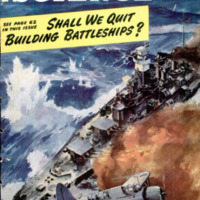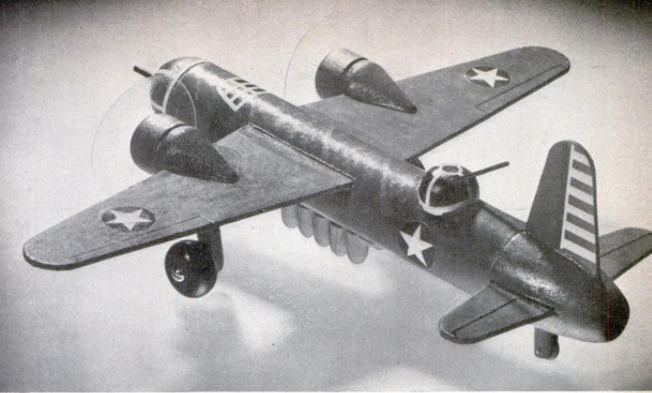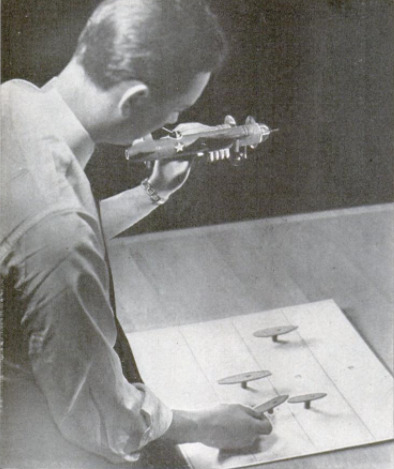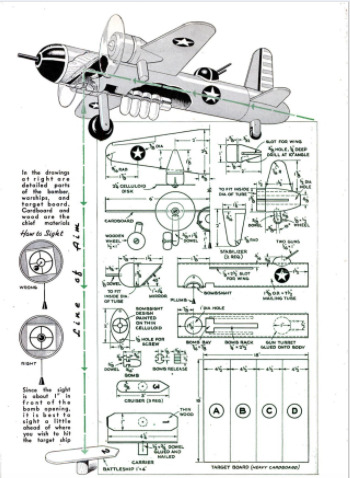-
Title (Dublin Core)
-
Naval bombing game
-
Article Title and/or Image Caption (Dublin Core)
-
Title: Naval bombing game
-
Subtitle: Features ingenious bombsight
-
extracted text (Extract Text)
-
ENEMY fleet sighted! . . . On target! . ..
Bombs away! . . . Here's a realistic
naval bombing operation brought to your
parlor floor in miniature, and a fascinating
game that's bound to make a direct hit with
everyone who plays—and anyone can. All
the thrills of an actual aerial attack are
present; the bomber “flies” over the forma-
tion of warships below, selects a carrier,
battleship, or cruiser for blasting out of the
sea, gets into position over it, and releases
the bombs over the target.
The bomber is made almost entirely of
wood and cardboard, painted olive drab,
and decorated with insignia and representa-
tions of pilot's cabin, ailerons, elevators,
gunner's turret, cannon, and so forth. The
fuselage, wing, stabilizer, and rudder are
cardboard, while the nose, tailpiece, motors,
turret, wheel assemblies, and bombs are
made of wood. The bombsight is an ingen-
ious device consisting of a mirror,
guide lines, and a miniature plumb
bob. The only other materials
needed in the construction are
some small pieces of celluloid.
To make the fuselage, cut a
1 3/8” 0.d. cardboard mailing tube
to a length of 7 1/2”. Cut out a 1” hole with
its center 7/8 from one end, and glue a cel-
luloid strip, on which the bombsight pattern
is inked or painted, over this hole, securing
it also with small screws and nuts. Punch a
small hole in the precise center, and through
this, thread a plumb line 3/4” long with a
small weight on its end. Cut a 7/16” by 7/8"
opening for the bomb bay, measuring 1 5/8"
from this same end of the fuselage, as
shown in the drawing. For the bomb rack,
extend a 1/4” wide slot on a direct line with
the bombsight center to a length of 2 1/2”.
To complete the fuselage, make the wing
slots, as shown, and glue on the rear gun
turret, which is shaped to fit the tube.
The nosepiece is made of wood, shaped
as indicated, with a small mirror fastened
to it at a 45-deg. angle. For the tail, a
piece of wood of the same diameter as the
fuselage is shaped to size and a 12” hole is
bored through it for sighting. Slots are
made to receive the vertical fin and stabi-
lizers, which are cut from cardboard, and
a hole is then bored diagonally in
the bottom for the tail wheel.
Cut a 12” long wing from card-
board, insert it in the slot in the
fuselage, and glue it in place.
The twin motors are 1” in diam-
eter, tapered to a length of 2”,
slotted for a snug fit on
the wing, and bored diag-
onally underneath for the
3/8 " dowel that supports
the landing-gear assembly.
Celluloid disks 2 1/4” in di-
ameter are fastened to
the motors to simulate
spinning propellers.
The bombs are made
from 3/8” dowel, grooved
to hang in the bomb rack,
while the bomb release is
fashioned from 1/2” wood
dowel, formed as to slide
along the bomb-rack slot.
This arrangement makes
it a simple matter to re-
lease one bomb at a time.
Ships are of thin wood,
with a 1/2” wood dowel as
support. They are cut to
the three shapes and sizes
indicated, then painted
battleship gray, and num-
bered as follows: cruisers,
“3”; battleship, “2"; car-
rier, “1.
-
Contributor (Dublin Core)
-
Myron Fleishman (Toy and Game designer)
-
Language (Dublin Core)
-
eng
-
Date Issued (Dublin Core)
-
1943-04
-
pages (Bibliographic Ontology)
-
HW 65-HW 67
-
Rights (Dublin Core)
-
Public Domain (Google Digitized)
-
Archived by (Dublin Core)
-
Matteo Ridolfi
-
Marco Bortolami (editor)
 Popular Science Monthly, v. 142, n.4, 1943
Popular Science Monthly, v. 142, n.4, 1943






